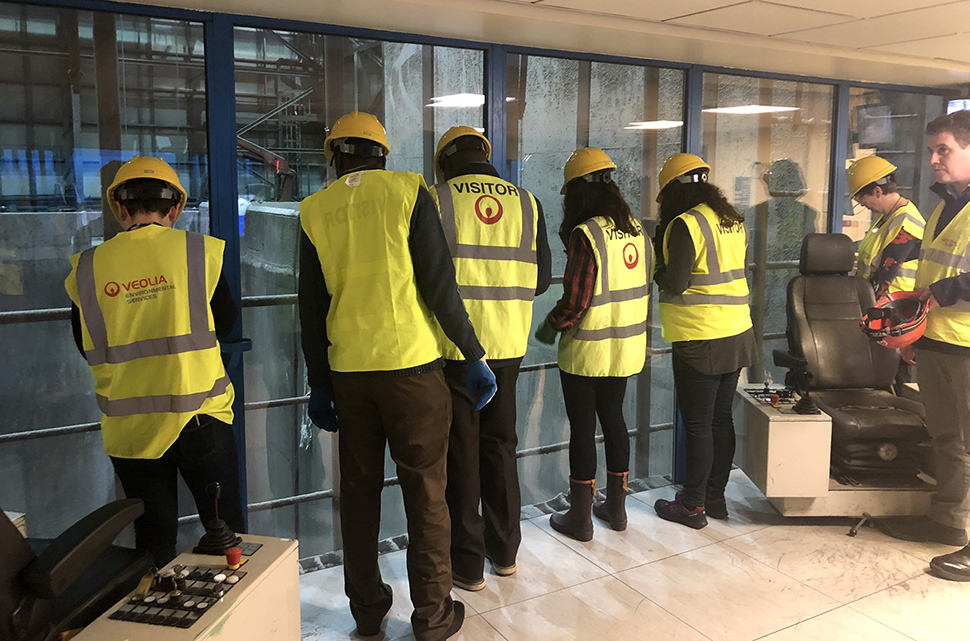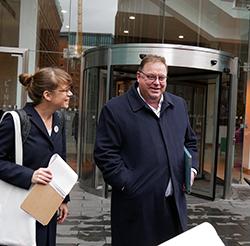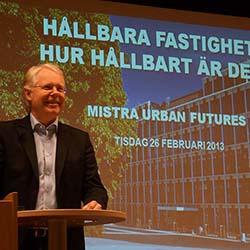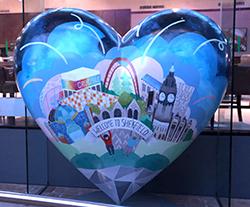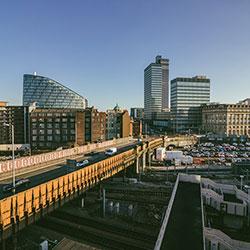Feeling the heat: tracing Sheffield's district energy network to its source
Dr Aimee Ambrose, Reader in Energy Policy, The Centre for Regional Economic and Social Research, Sheffield Hallam University
On 14th October I led a walking tour of Sheffield's district energy network (DEN) as part of the Just Cites conference. Sheffield's DEN is one of the largest in the UK, generating and distributing heating and hot water to hundreds of buildings around the city centre and inner city as well as generating electricity for export to the national grid. The DEN is powered by burning domestic and non-domestic waste collected from across the city and surrounding area- just about anything that you put in a general refuse bin in Sheffield will end up at the Sheffield Energy Recovery Facility (ERF) to be burnt at 850 degrees celsius and turned into heat and power.
The idea of leading a tour for conference delegates really appealed to me partly because I'm a big fan of walking methods in my research and like to combine them with first hand encounters with energy generation to show people where their energy is coming from. Since we stopped burning fossil fuels in our homes to generate heat and light, we've lost touch with where our energy is coming from and what is being burnt to generate it. Energy has become essential yet invisible in our everyday lives. Using walking tours in an energy context is a great way to reconnect us with the realities of contemporary energy generation and it's something I'm using extensively in my Walking with Energy project which seeks to promote greater awareness of and engagement with energy policy amongst Swedish citizens.
We started the tour at a popular cafe on the edge of Sheffield City Centre. We indulged in some coffee and cake while I explained the programme for the event and convinced the participants to be guinea pigs for a new psychological test that my colleagues and I have developed as part of the Walking with Energy project. It seeks to test the impact of first hand encounters with energy generation on awareness of and attitudes towards environmental issues. The main attraction of this cafe was not just the excellent coffee and cake, but the fact that the district heating pipeline delivering heat to Sheffield Hallam University and surrounding buildings runs right next to it. Our next step was to walk the pipeline and trace it to its source at the ERF about a mile out of town.
Immerse participants in the energy landscape
Walking the pipeline is an idea inspired by the work of Vanesa Castan Broto who has worked extensively with walking methods in an urban energy context and has spent time walking unfamiliar neighbourhoods with their inhabitants in a bid to immerse herself and her participants in the energy landscape. She has used this technique to understand relationships between citizens and energy infrastructure and the ways in which it has shaped and been shaped by the development of cities. Her conception of walking as a means of appreciating the 'extraordinary ordinariness' of energy landscapes and identifying what is distinctive in landscapes that have become familiar and indistinct to those around them, has been a significant influence on my work.
Episodes in the city
As we walked the pipeline we paused at key buildings along the way and talked about their relationship to the DEN and used them to illustrate different episodes in the city's development. For example, we paused at Ponds Forge International Sports Centre- one of the DEN's biggest customers- and talked about the role of the World Student Games in levering regeneration funding into Sheffield following deindustrialisation. Our penultimate stop before reaching the ERF was the gargantuan Park Hill flats complex- an internationally renowned architectural icon of the modernist era and Europe's largest listed building. We gathered under a tree in an attempt to shelter from the heavy rain and stared up at the 13 storey high looming concrete façade of the flats. I explained a bit about the fascinating energy history of the flats- how their design incorporated its own heat generation facility which was fed by the refuse from the flats and how this was later subsumed into the DEN; how the first residents would have been overwhelmed by the comfort and convenience of life in the modern flats when they moved in from the neighbouring slums and how, in future, the flats may be converted to electric heating for the convenience of the developer renovating the building. The flats exemplify many different energy transitions and I hope the delegates felt it was worth getting soggy to hear their fascinating story.
Questions about carbon emissions
On reaching the ERF, we soon dried off in the (unsurprisingly) very warm meeting room, where the General Manager, Guy Le Geyt, gave us a comprehensive overview of the facility and the DEN it feeds. The group were very engaged with the talk and weren't afraid to ask probing questions about the carbon emissions associated with the ERF. Guy challenged the group to think about the heat and energy being generated as a by-product of a waste management process and argued that the carbon emissions from the plant compared favourably to the methane emitted from landfill. We also gained interesting (and candid) insights into how the uneven demand profile associated with the DEN is managed and how the financial model for the network operates.
Visit to 'the pit'
Next we took an access all areas tour of the facility which included a visit to 'the pit'- the vast chasm where refuse from around the city pours in everyday and is held before it is transferred to the incinerator. Participants remarked on the composition of the waste- large amounts of plastic, cardboard and textiles were visible as well as organic material and nappies. The pit is awe inspiring and as the waste pours in and churns over, it can represent an uncomfortable encounter with the consequences of our over consumption. I hope that the participants enjoyed their walk with energy and took away a new perspective on the energy infrastructure beneath their feet.
/Dr Aimee Ambrose
